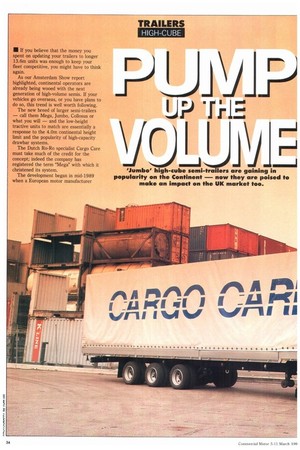i\A P
Page 36

Page 37

If you've noticed an error in this article please click here to report it so we can fix it.
UP
I I Ell 'Jumbo' high-cube semi-trailers are gaining in popularity on the Continent — now they are poised to make an impact on the UK market too.
• If you believe that the money you spent on updating your trailers to longer 13.6m units was enough to keep your fleet competitive, you might have to think again.
As our Amsterdam Show report highlighted, continental operators are already being wooed with the next generation of high-volume semis. If your vehicles go overseas, or you have plans to do so, this trend is well worth following.
The new breed of larger semi-trailers — call them Mega, Jumbo, Collosus or what you will — and the low-height tractive units to match are essentially a response to the 4.0m continental height limit and the popularity of high-capacity drawbar systems.
The Dutch Ro-Ro specialist Cargo Care must take much of the credit for the concept; indeed the company has registered the term "Mega" with which it christened its system.
The development began in mid-1989 when a European motor manufacturer
asked several transport companies (and not just road transport firms) to look at the best way of transporting parts from the Continent to the UK and vice-versa. Cargo Care's fleet manager Hans van Maanen takes up the story: "We looked at whether we could make a means of transport which combined the positive features of the Philips drawbar system, such as a 3.0m internal height, with the positive features of semi-trailers, which can be sent unaccompanied on ferries."
Beginning with the theoretical continental semi-trailer limits (a box 13.6x4.0x2.5m, or 136m3), Cargo Care looked at ways of ensuring that as much of this cube as possible was available for the load. As van Maanen explains: "We thought that a 3.0m height was possible. The Philips uses an 80cm high chassis, so we asked, 'Why can't the technology of a drawbar be used on a unit and semi-trailer?' "
Having discussed some ideas with suppliers Cargo Care began to see how it could achieve its target: combining a thinner roof, a self-supporting neck and a tractor with a laden fifth-wheel height of 94cm gave the desired internal height within the allowed 4.02m limit.
At this point Cargo Care let the specialists at the trailer and running gear manufacturers get to work, resulting in six prototype Mega semis being ordered from Van Hoot and Krone; these began extensive operational trials in February 1990 with special low-height tractors from MAN and Scania.
By the beginning of 1991 the company stepped up its programme and ordered a further 50 trailers split between its two suppliers.
"In the meantime the truck industry started to recognise the possibilities of the concept," says van Maanen, who points to the availability of 285/60 R 22.5 tyres from city buses as an important factor in the development of compatible tractive units.
The Mega concept has particular advantages for the sort of unaccompanied cross-Channel work that is Cargo Care's speciality.
The most immediate bonus comes from the ability to stack goods higher than on a standard-height semi. Good examples are white goods such as washing machines, where the load -----can be three-high rather
1.•••••••••■•••11












































































































